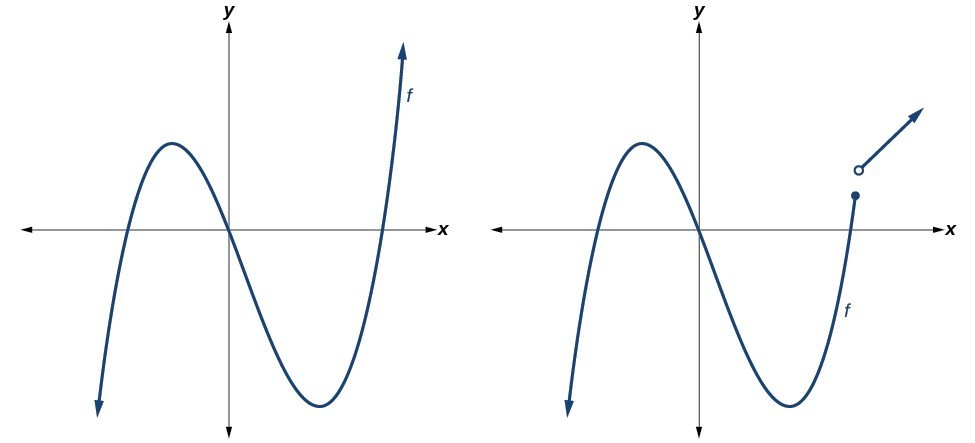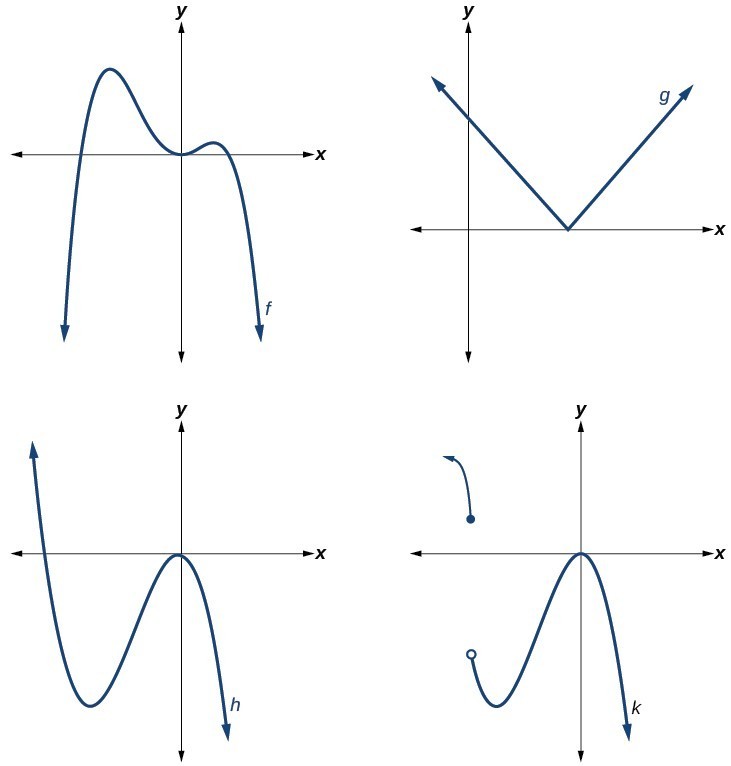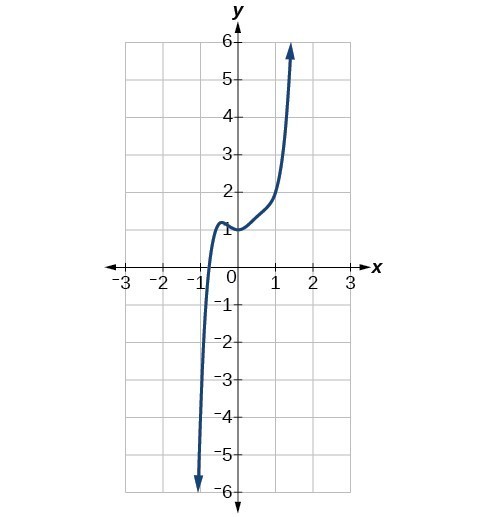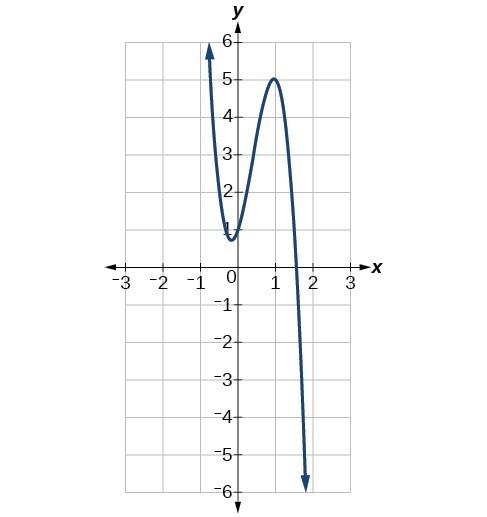Learning Outcomes
- Identify graphs of polynomial functions
- Identify general characteristics of a polynomial function from its graph
Plotting polynomial functions using tables of values can be misleading because of some of the inherent characteristics of polynomials. Additionally, the algebra of finding points like x-intercepts for higher degree polynomials can get very messy and oftentimes be impossible to find by hand. We have therefore developed some techniques for describing the general behavior of polynomial graphs.
Polynomial functions of degree [latex]2[/latex] or more have graphs that do not have sharp corners. These types of graphs are called smooth curves. Polynomial functions also display graphs that have no breaks. Curves with no breaks are called continuous. The figure below shows a graph that represents a polynomial function and a graph that represents a function that is not a polynomial.

Example
Which of the graphs below represents a polynomial function?

Q & A
Do all polynomial functions have “all real numbers” as their domain?
Yes. Any real number is a valid input for a polynomial function.
Identifying the Shape of the Graph of a Polynomial Function
Knowing the degree of a polynomial function is useful in helping us predict what its graph will look like. Because the power of the leading term is the highest, that term will grow significantly faster than the other terms as x gets very large or very small, so its behavior will dominate the graph. For any polynomial, the graph of the polynomial will match the end behavior of the term of highest degree.
As an example, we compare the outputs of a degree [latex]2[/latex] polynomial and a degree [latex]5[/latex] polynomial in the following table.
| x | [latex]f(x)=2x^2-2x+4[/latex] | [latex]g(x)=x^5+2x^3-12x+3[/latex] |
| [latex]1[/latex] | [latex]4[/latex] | [latex]8[/latex] |
| [latex]10[/latex] | [latex]184[/latex] | [latex]98117[/latex] |
| [latex]100[/latex] | [latex]19804[/latex] | [latex]9998001197[/latex] |
| [latex]1000[/latex] | [latex]1998004[/latex] | [latex]9999980000000000[/latex] |
As the inputs for both functions get larger, the degree [latex]5[/latex] polynomial outputs get much larger than the degree [latex]2[/latex] polynomial outputs. This is why we use the leading term to get a rough idea of the behavior of polynomial graphs.
There are two other important features of polynomials that influence the shape of its graph. The first is whether the degree is even or odd, and the second is whether the leading term is negative.
Even Degree Polynomials
In the figure below, we show the graphs of [latex]f\left(x\right)={x}^{2},g\left(x\right)={x}^{4}[/latex], and [latex]h\left(x\right)={x}^{6}[/latex] which all have even degrees. Notice that these graphs have similar shapes, very much like that of a quadratic function. However, as the power increases, the graphs flatten somewhat near the origin and become steeper away from the origin.

Odd Degree Polynomials
The next figure shows the graphs of [latex]f\left(x\right)={x}^{3},g\left(x\right)={x}^{5}[/latex], and [latex]h\left(x\right)={x}^{7}[/latex] which all have odd degrees. 
Notice that one arm of the graph points down and the other points up. This is because when your input is negative, you will get a negative output if the degree is odd. The following table of values shows this.
| x | [latex]f(x)=x^4[/latex] | [latex]h(x)=x^5[/latex] |
| [latex]-1[/latex] | [latex]1[/latex] | [latex]-1[/latex] |
| [latex]-2[/latex] | [latex]16[/latex] | [latex]-32[/latex] |
| [latex]-3[/latex] | [latex]81[/latex] | [latex]-243[/latex] |
Now you try it.
Example
Identify whether each graph represents a polynomial function that has a degree that is even or odd.
a)

b)

The Sign of the Leading Term
What would happen if we change the sign of the leading term of an even degree polynomial? For example, let us say that the leading term of a polynomial is [latex]-3x^4[/latex]. We will use a table of values to compare the outputs for a polynomial with leading term [latex]-3x^4[/latex] and [latex]3x^4[/latex].
| x | [latex]-3x^4[/latex] | [latex]3x^4[/latex] |
| [latex]-2[/latex] | [latex]-48[/latex] | [latex]48[/latex] |
| [latex]-1[/latex] | [latex]-3[/latex] | [latex]3[/latex] |
| [latex]0[/latex] | [latex]0[/latex] | [latex]0[/latex] |
| [latex]1[/latex] | [latex]-3[/latex] | [latex]3[/latex] |
| [latex]2[/latex] | [latex]-48[/latex] | [latex]48[/latex] |
The grid below shows a plot with these points. The red points indicate a negative leading coefficient, and the blue points indicate a positive leading coefficient:

The negative sign creates a reflection of [latex]3x^4[/latex] across the x-axis. The arms of a polynomial with a leading term of [latex]-3x^4[/latex] will point down, whereas the arms of a polynomial with leading term [latex]3x^4[/latex] will point up.
Now you try it.
Example
Identify whether the leading term is positive or negative and whether the degree is even or odd for the following graphs of polynomial functions.
a)

b)

Candela Citations
- Revision and Adaptation. Provided by: Lumen Learning. License: CC BY: Attribution
- College Algebra. Authored by: Abramson, Jay, et al.. Provided by: OpenStax. Located at: http://cnx.org/contents/fd53eae1-fa23-47c7-bb1b-972349835c3c@5.175. License: CC BY: Attribution. License Terms: Download for free at: http://cnx.org/contents/fd53eae1-fa23-47c7-bb1b-972349835c3c@5.175
